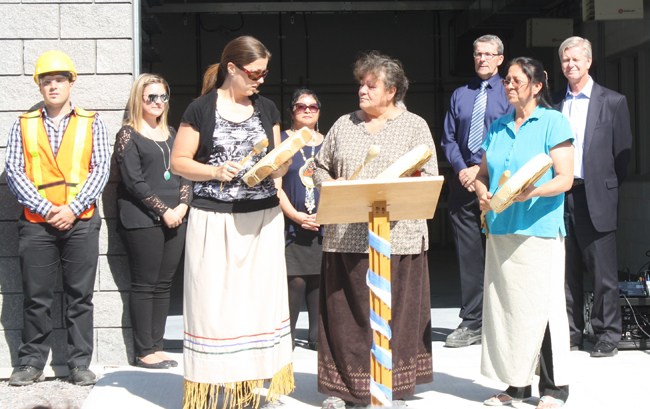‘Safe water is a basic human right’ says Chief Johnston

By Leslie Knibbs
SERPENT RIVER FIRST NATION – Chief Elaine Johnston, welcomed dignitaries and community members to the Sept. 23 grand opening of the Serpent River First Nation Water Treatment Plant.
Chief Johnston told everyone the plan for building the plant “was 30 years in the making.” She noted that back in 2010 the United Nations declared, “safe water is a basic human right”.
Back on January 30, 2014, SRFN signed a contract with the Tribury-Matheson Group for the construction phase of the $13.3 million project to be completed in August, 2015. Serpent River contributed $750,000 to the project budget, with the federal government paying the balance. The First Nation received 10% , or $1.3 million in “local content” considerations, including employment for community residents.
SRFN is 95% bordered by water – the North Channel of Lake Huron and the Serpent River basin — allowing access to fresh water for the treatment plant. Prior to completion of the treatment plant, community members had depended on a communal well system and individual wells for water, with quality and quantity of water being inconsistent. With the new plant operational, all homes and structures within the village can now access clean potable water from the plant with the exception of seven homes who remain on individual wells. According to Chief Johnston, rock formations prohibit their access to the new plant; however, all individual wells are in good shape and ongoing work will resolve the water delivery problem.
Construction of the plant began 27 months ago and came in under budget with a surplus of $600,000. as a result of negotiations with Ontario Hydro who agreed to waive their costs on the construction under the condition that SRFN enter into an agreement to continue using Ontario Hydro service at the plant for a period of five years.
According to the original agreement, any surplus was only to be used for construction purposes related to the treatment plant. SRFN made a written request to Aboriginal Affairs and Northern Development Canada (AANDC) asking that the surplus be used for much needed fire protection services in the community. This request was turned down under the terms of the original agreement. Not pleased with this negative response, Chief Johnston is persisting in her efforts to direct the surplus towards fire protection. Local MP Carol Hughes is assisting SRFN in their efforts to obtain needed fire protection using the surplus, by writing a letter of support to AANDC asking that they reconsider their decision and allow the surplus to be put to good use for needed fire protection.
Much credit was given to J.L Richards and Associates for designing and overseeing the building of the treatment plant. John Cannard, an associate with Richards said he was “most impressed with the strength of the community and how they got behind it with support.”
Because of the many streams entering the lake where the water is pumped from, Cannard said his firm was confronted with a unique situation, the largest concern was the organic matter in the water from the many streams and streamlets entering the lake in SRFN area. According to Cannard, the design used in SRFN originates from Scotland in the UK where there are many similar environments. Cannard said this design is also used in “swampy areas” and is totally effective in providing fresh clean potable water.
After giving thanks to the creator, Chief Johnston thanked all the community acknowledging those involved in initiating the original application process in 2009 including former SRFN Chief Isadore Day, now Ontario Chief, James Owl, former directors of operations Tony Moor and Nishin Meawasige as well as others.
When asked if water usage will be monitored and user fees implemented, Chief Johnston reiterated Chief Day’s response to this question in 2014 stating, at this time it is unclear if user fees will be required to cover the plants operational costs.
Following a closing drum song, community members toured the new facility then enjoyed a lunch provided by the Band Hall caterer.


